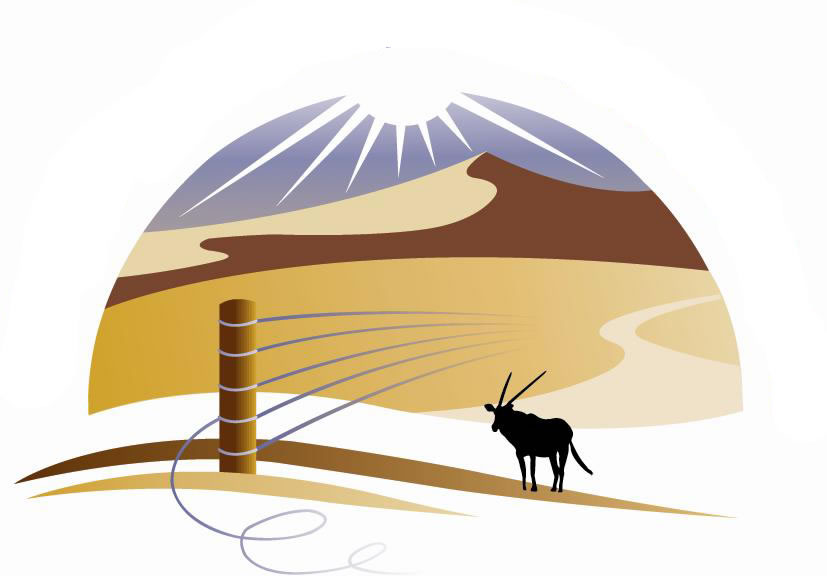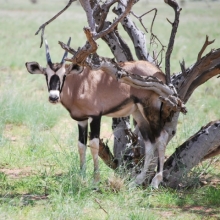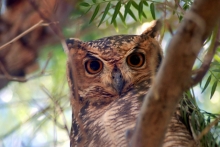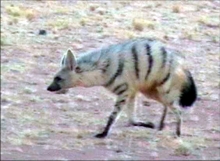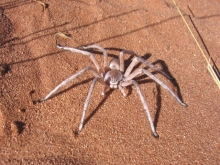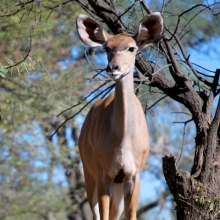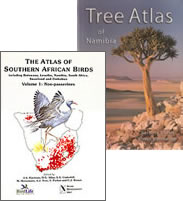Fauna
The fauna of the Greater Sossusvlei-Namib Landscape includes many species which are highly specialised and able to thrive in the harsh conditions. While much of the area is sand sea, there is a considerable diversity of available habitats and comparatively high species diversity of some taxa such as reptiles.
Birds
Over 370 bird species have been recorded in the Greater Sossusvlei-Namib Landscape.
Of these only 100 species have been recorded in the Namib Sand Sea and few live permanently in this hyper arid habitat. Most are dependent on habitats adjacent to the dunes while using the dunes as foraging areas, for example owls or pale chanting goshawks, or are simply passing by. Ostriches may live permanently in the Namib Sand Sea but are not endemic. Only the dune lark is endemic (and permanently resident) in the Namib Sand Sea. Larks are highly successful in arid habitats. Nine species altogether are found occasionally in the dunes. Lappetfaced vultures, Torgos tracheliotus, are a spectacular part of the fauna of the Namib Sand Sea breeding in trees in the ephemeral rivers that penetrate the dunes. Ludwig’s bustards, Neotis ludwigii, are amongst the largest bustards in existence. These spectacular birds move widely across the landscape particularly after a good rain and emergence of numerous tenebriond beetles and other insects on the dunes.
Mammals
Two small mammals are endemic to the Namib Sand Sea: the golden mole Eremitalpa granti namibensis and dune gerbil Gerbillurus paeba. Other gerbil species frequent this habitat but are not confined to it. A variety of larger mammals enter the Namib Sand Sea for shorter or longer periods. These include the gemsbok, Oryx gazella, springbok, Antidorcas marsupialis, and Cape hare, Lepus capensis, which may remain for months or even a lifetime. Common short-term visitors include predators such as the black-backed jackal, Canis mesomelas, brown hyaena, Hyaena brunnea, Cape fox, Vulpes chama and spotted hyaena, Crocuta crocuta. A greater variety of desert animals may follow an ephemeral river into the dune sea but not travel far into the Namib Sand Sea itself.
The Namib golden mole: This small, blind, subterranean insectivore, Eremitalpa granti namibensis measures about 8 cm long, and possesses a silky greyish-yellow coat with a silvery sheen. The first living specimens were found in the dunes near the Gobabeb Training and Research Centre in the late 1950s. The species was previously known only from scattered remains in owl pellets. The claws on the front feet are broad and hollowed out to serve as modified shovels for digging through loose sand. Unlike other subterranean animals, the Namib golden mole lacks an underground burrow system, but ‘swims’ through the fluid, oxygenated sand of the Namib Sand Sea and emerges onto the surface to forage for its prey.
Reptiles
The landscape supports a rich reptile diversity.
Invertebrates
The overall diversity of organisms in the entire Namib Desert is comparable to that of any other desert but what distinguishes the Namib Sand Sea is the diversity of hyper and ultra psammophilous (sand-loving) species as well as the level of endemicity. The large number of sand sea endemics with their specialised adaptations to live in sand, which does not allow them to successfully colonise any other habitat except unconsolidated sand, are labelled ‘ultrapsammophilous’ and ‘hyperpsammophilous’. Animals in the Namib Sand Sea can literally swim smoothly through the sand. By swimming down to a depth of about 300 mm, they can reach a comfortable temperature, which does not vary between day and night, and varies only about 10°C between summer and winter. The animals which seem to benefit most from the spectacularly unique properties of the Namib sand particles are invertebrates. Many species of beetle can forage for long periods on the sand surface during the day because they can escape so easily if and when they get hot or predators appear. However, much larger animals can use sand swimming locomotion too. Although some take advantage of the surface, a vast majority has found some way to live part or all of the time in the extraordinary conditions available beneath the sand surface.
|
|
Plants |
Arachnids |
Insects |
Reptiles |
Mammals |
Birds |
|
Sand sea spp. |
15 |
44 |
207 |
18 |
12 |
9 |
|
Endemic spp. |
8 |
37 |
108 |
8 |
2 |
1 |
|
% Endemism |
53 |
84 |
52 |
44 |
17 |
11 |
Two suites of Namib Sand Sea fauna can be biogeographically distinguished – a coastal suite and an inland or eastern component.
Relevant literature
-
Greater Sossusvlei Namib Landscape: Tracking ungulate movements 1
Greater Sossusvlei Namib Landscape: Tracking ungulate movements
Greater Sossusvlei Namib Landscape : Tracking ungulate movements. Volume 1 Issue 1: from December 2015 to March 2016» Download -
Greater Sossusvlei Namib Landscape: Tracking ungulate movements 2
Greater Sossusvlei Namib Landscape: Tracking ungulate movements 2
Greater Sossusvlei Namib Landscape Tracking ungulate movements. Volume 1 Issue 2: from April to June 2016» Download -
Greater Sossusvlei Namib Landscape: Tracking ungulate movements 3
Greater Sossusvlei Namib Landscape: Tracking ungulate movements 3
Greater Sossusvlei Namib Landscape Tracking ungulate movements. Volume 1 Issue 3: from June to November 2016» Download -
Greater Sossusvlei Namib Landscape: Tracking ungulate movements 4
Greater Sossusvlei Namib Landscape: Tracking ungulate movements 4
Greater Sossusvlei Namib Landscape Tracking ungulate movements. Volume 2 Issue 1: from December 2016 to March 2017» Download -
NRNR Game Count report June 2012
Report giving feedback and results of the annual game count held on NamibRand Nature Reserve and the Pro-Namib Conservancy on 2 June 2012 - for the eighth consecutive year since the counts were initiated in 2005.» Download -
NRNR Game Count report May 2013
Results of the Annual Game Count for the NamibRand Nature Reserve and Pro-Namib Conservancy 1 June 2013
Data collected in the June 2013 game count were calculated and analysed, bearing our three core objectives in mind: Population estimates, Wildlife distribution/density, Population change» Download -
NRNR Game Count report May 2014
Results of the NamibRand Nature Reserve and Pro-Namib Conservancy Annual Game Count 31 May 2014
Data collected in the May 2014 game count were calculated and analysed, bearing our three core objectives in mind: Population estimates, Wildlife distribution/density, Population change» Download -
Observations on the movements and home ranges of Hartmann’s Mountain Zebras and Oryx in the Greater Sossusvlei-Namib Landscape
Mendelsohn J. 2014. Observations on the movements and home ranges of Hartmann’s Mountain Zebras and Oryx in the Greater Sossusvlei-Namib LandscapeThis document provides a summary of information on the movements and locations of 9 Hartmann’s mountain zebra and 9 oryx fitted with GPS tracking devices in the Greater Sossusvlei-Namib Landscape during 7 months in 2013 and 2014.» Download -
Observations on the movements and home ranges of Hartmann’s Mountain Zebras and Oryx in the Greater Sossusvlei-Namib Landscape
Mendelsohn J & Mendelsohn M, 2014. Observations on the movements and home ranges of Hartmann’s Mountain Zebras and Oryx in the Greater Sossusvlei-Namib Landscape. Update December 2014
This document provides an update of information on the movements and locations of 9 Hartmann’s mountain zebra and 9 oryx in the Greater Sossusvlei-Namib Landscape (GSNL). The report covers one year: from the last days of November 2013 when the transmitters were fitted to the end of November 2014. A previous report reviewed data collected during the first 7 months up to the 26th of June 2014.» Download -
Observations on the movements and home ranges of Hartmann’s Mountain Zebras and Oryx in the Greater Sossusvlei-Namib Landscape (powerpoint)
Observations on the movements and home ranges of Hartmann’s Mountain Zebras and Oryx in the Greater Sossusvlei-Namib Landscape. Based on a report by John Mendelsohn (RAISON)
A 16 slide powerpoint presentation summarising the results of the study of nine mountain zebra and nine oryx fitted with GPS tracking devices in the central Namib, showing locations and home ranges to date (after 7 months tracking).» Download -
Project proposal: A study of the population densities, movement patterns and land uses of oryx, springbok and mountain zebra in and around the Greater Sossusvlei-Namib Landscape
African Conservation Services cc. 2013. Project proposal: A study of the population densities, movement patterns and land uses of oryx, springbok and mountain zebra in and around the Greater Sossusvlei-Namib Landscape.
» Download -
Report on a mountain zebra aerial survey in the Naukluft and Khomas Hochland
Kolberg H. 2013. Report on a mountain zebra aerial survey in the Naukluft and Khomas Hochland, 19 to 24 June 2013
» Download -
Report on the Burchell’s Zebra and Red Hartebeest total road count June 2014
Report on the Burchell’s Zebra (Equus burchelli) and Red Hartebeest (Sigmoceros lichtensteinii) total road count done on the 24th of June 2014
Population estimates for NamibRand Nature reserve were 367 Burchell's zebra and around 205 Red hartebeest.» Download -
Species list: Birds
Bird species list compiled from data in the Southern African Bird Atlas Project and from more recent records within the landscape.» Download -
Species list: Mammals
Mammals recorded by NamibRand Nature Reserve» Download -
Species list: Reptiles
Reptiles recorded by NamibRand Nature Reserve» Download -
Ungulate tracking update: December 2015 to November 2016. Central section.
Ungulate tracking update: December 2015 to November 2016. Central section.
Animation showing movement of satellite-tracked ungulates between December 2015 and November 2016. Central section» Download -
Ungulate tracking update: December 2015 to November 2016. Nothern section.
Ungulate tracking update: December 2015 to November 2016. Nothern section.
Animation showing movement of satellite-tracked ungulates between December 2015 and November 2016. Nothern section.» Download -
Ungulate tracking update: December 2015 to November 2016. Southern section
Ungulate tracking update: December 2015 to November 2016. Southern section.
Animation showing movement of satellite-tracked ungulates between December 2015 and November 2016. Southern section» Download
